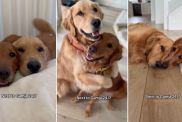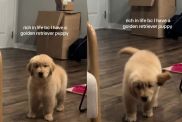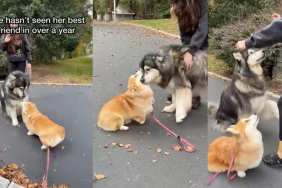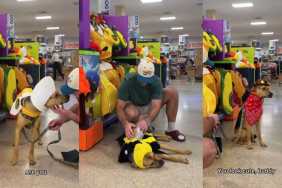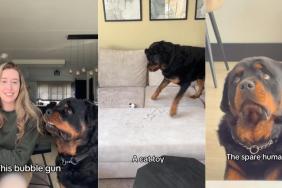House training a puppy can be hard, but nobody likes cleaning up doggie accidents–especially when they’re in your own home. Here are some tips to help train your dog to avoid making those messes in the first place.
A Crate Idea
Whether housebreaking a pup or an adult dog, the first step is taking advantage of the dog’s den instinct (their desire to curl up in a snug, protected place). A crate, when properly introduced as a happy and rewarding place, provides your pet a secure haven of its very own. It’s invaluable for housebreaking because most dogs will not soil their sleeping quarters. (An exception might be a dog from a puppy mill situation, who has been forced to potty in the same area where they sleep. It can take these dogs a bit longer to understand the difference between their living quarters and their potty areas.)
What size crate do you need? Start with one that’s smaller than you may use later on–one that is just big enough for the dog to stand up, turn around and lie down comfortably. If the crate is too big, the pup may feel he can potty and still get away from it. An easy-to-clean plastic crate works well, or you may opt for a wire crate, which can be covered with a towel or blanket, if needed, to make the dog feel more secure.
Introduce the crate in a positive manner. Get your pup used to going in the crate by tossing in small treats while the door is open. Most dogs will venture in to get the treats. Once they are comfortable going in to eat the treat, you can briefly shut the door, stand right in front and hand your dog treats through the door, then open it and let them back out. If you also use the crate to feed your dog his regular meals, he will quickly associate it as a pleasurable place.
You’ll also need to outfit their crate with some bedding. If the dog does not chew fabric or soil bedding, you can use a towel or light blanket inside the crate. Newspaper is not a good idea, as it may send the message of “potty here,” especially if the dog was previously trained to go on paper. A few dogs will urinate in a crate if bedding is provided. If your dog does this, remove the bedding until the pup starts to understand that bedding is for sleeping–not for a potty pad!
Whenever your dog is not directly under your supervision in the house, it should be in its crate or kennel. Preventing potty mistakes by not allowing an accident to happen will help the dog understand these concepts much quicker. Whenever you take pup out of the crate, make sure you immediately go to the potty area, every single time, even if your pup was crated for only 15 minutes. When you reach the area, set your pup down, or if the dog is on leash, put a little slack in the leash, and say a phrase such as “go potty” or “do your business.” When your pup actually begins to go, repeat the phrase quietly while he is going. Don’t use a loud, excited voice, as this may cause the pup to become distracted and forget what he or she is doing.
Consistency is key! Be consistent even in which door you use to go outside, and be consistent with feeding schedules, go-potty phrases and places, as well as exercise schedules. Even if your dog just came back inside, if it drinks a lot of water or starts doing something they were not before–take them back out to potty! Sniffing the floor, circling, whining, wandering away, or heading toward the door are often signals that your pup needs to go, which means you need to be quick in taking them outside!
How often do they need to go out? Pups normally eliminate a few minutes after eating or drinking, and again about 20-30 minutes later. Keep in mind that some dogs will actually poop twice in one outing, so walk them long enough to make sure everything is taken care of before coming back inside. Also, when dogs have been playing and drinking water, they will have to go out more often, sometimes even every half hour if they are out with you instead of sleeping in their crate.
When Accidents Happen
When an accident does happen, first use a rag or paper towel to soak up urine and/or pick up feces. Clean the spot with a good carpet cleaner, and then follow up with an enzyme cleaner formulated to neutralize odors. Once the spot is at least partially dry, spray it with a dog repellant spray such as Boundary™, or with a vinegar solution, to discourage future accidents in the same area. Be sure to put your pup out of sight as you clean, so you do not unintentionally “punish” when they have no idea what has been done wrong. Never scold a pup after the fact, and never scold for crate accidents. If you catch the pup just beginning the event, a quick “no” in a calm voice, followed by rushing pup outside can sometimes be helpful.
Having problems housebreaking an older pup or adult? First, rule out a medical condition (such as a urinary tract infection) by a quick trip to the vet. If everything checks out okay, make sure you are truly observing the rule of keeping the dog right beside you whenever they are out of the crate (so you do not miss any signals).
If you are dealing with a male who was not neutered at an early age and has a desire to mark territory even after being neutered, then you may find a “belly band” helpful. Almost all small dogs accept them quickly. These can be ordered in pet supply catalogs or over the internet, or for small dogs, it is easy enough to make your own with a tube sock and Velcro™. Just wrap it around the dog’s middle, with a sanitary pad in the place where the dog would urinate.
For female dogs, purchase doggie panties, which are used for females in season, and use them in the house, taking them off just before you take the dog outside to potty (the same way you would if using a belly band for a male dog.) Be sure to change the pad if the dog does urinate on it. If you are consistent enough to prevent accidents through the use of the bands or panties, plus you are continuing to take the dog outside on a regular basis, most dogs get the idea within a month or so.
Some pups will urinate from excitement when greeting people, or when showing submissive behavior. These dogs do best if you ignore them when you first arrive, and then let them come to you later after you have sat down. Do not scold for this behavior, as this can make the problem worse. If you ignore it, usually it is outgrown. If the behavior continues past the age of 6 months, your vet may prescribe some medication to help solve the problem, and you may also wish to work with a behavior counselor to make sure that your pup’s confidence is increased (which will lessen urinating that is related to submissive behavior.)
Keeping it Comfortable
Don’t forget your dog’s social needs! The best place for your new dog to be crated the first few nights is directly beside your bed, close enough that you can stick your fingers in if needed for comfort. Keep in mind that puppies are especially prone to fear of being alone, as they have always had plenty of “company” from their Mom and littermates.
If you have another dog, be sure to leave it crated beside your new pup, or at least have it in the same room with your pup’s crate whenever you leave the puppy alone. This helps prevent the feeling of “social isolation” when you are away. If you do not have another pet, then try leaving a radio or TV on in the room, at low volume. If you must be away all day at work, arrange to have a neighbor or relative come walk the dog in the middle of the day, or hire a professional dog-sitter. Doggie daycare can also be a good option if you have an experienced trainer in your area who offers this service. Always check with your veterinarian’s office for references.
Last but not least, always make sure that your pup gets a quick walk after he finishes going potty outside, and don’t immediately put him back in his crate the second he comes inside. If the fun always ends (they have to go right back to their crate) as soon as they “go,” some pups will prolong going so they can stay outside in the fresh area and enjoy your company a bit longer!
Source: Adapted from the Humane Society of the United States



